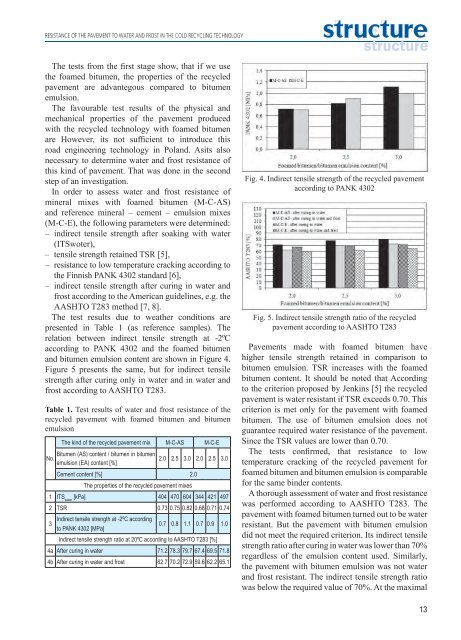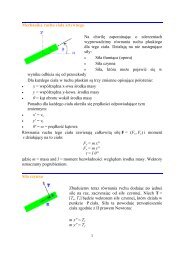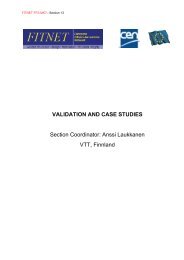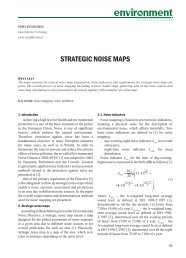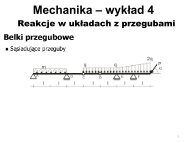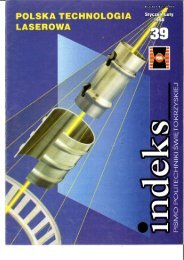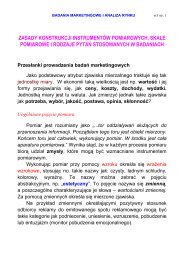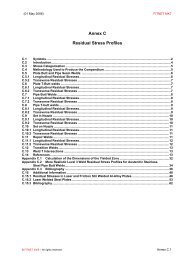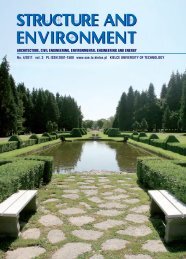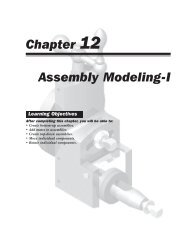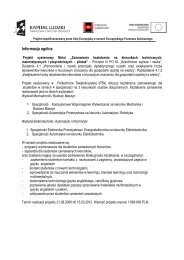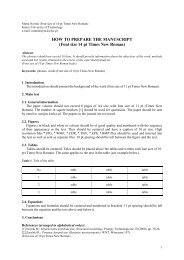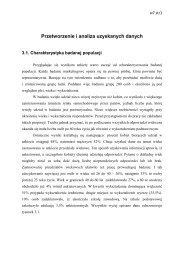Pobierz pełny numer 1/2010 S&E - Structure and Environment - Kielce
Pobierz pełny numer 1/2010 S&E - Structure and Environment - Kielce
Pobierz pełny numer 1/2010 S&E - Structure and Environment - Kielce
- No tags were found...
Create successful ePaper yourself
Turn your PDF publications into a flip-book with our unique Google optimized e-Paper software.
RESISTANCE OF THE PAVEMENT TO WATER AND FROST IN THE COLD RECYCLING TECHNOLOGYThe tests from the first stage show, that if we usethe foamed bitumen, the properties of the recycledpavement are advantegous compared to bitumenemulsion.The favourable test results of the physical <strong>and</strong>mechanical properties of the pavement producedwith the recycled technology with foamed bitumenare However, its not sufficient to introduce thisroad engineering technology in Pol<strong>and</strong>. Asits alsonecessary to determine water <strong>and</strong> frost resistance ofthis kind of pavement. That was done in the secondstep of an investigation.In order to assess water <strong>and</strong> frost resistance ofmineral mixes with foamed bitumen (M-C-AS)<strong>and</strong> reference mineral – cement – emulsion mixes(M-C-E), the following parameters were determined:– indirect tensile strength after soaking with water(ITSwoter),– tensile strength retained TSR [5],– resistance to low temperature cracking according tothe Finnish PANK 4302 st<strong>and</strong>ard [6],– indirect tensile strength after curing in water <strong>and</strong>frost according to the American guidelines, e.g. theAASHTO T283 method [7, 8].The test results due to weather conditions arepresented in Table 1 (as reference samples). Therelation between indirect tensile strength at -2ºCaccording to PANK 4302 <strong>and</strong> the foamed bitumen<strong>and</strong> bitumen emulsion content are shown in Figure 4.Figure 5 presents the same, but for indirect tensilestrength after curing only in water <strong>and</strong> in water <strong>and</strong>frost according to AASHTO T283.Table 1. Test results of water <strong>and</strong> frost resistance of therecycled pavement with foamed bitumen <strong>and</strong> bitumenemulsionNo.The kind of the recycled pavement mix M-C-AS M-C-EBitumen (AS) content / bitumen in bitumenemulsion (EA) content [%]2.0 2.5 3.0 2.0 2.5 3.0Cement content [%] 2.0The properties of the recycled pavement mixes1 ITS water[kPa] 404 470 604 344 421 4972 TSR 0.73 0.75 0.82 0.68 0.71 0.743Indirect tensile strength at -2ºC accordingto PANK 4302 [MPa]0.7 0.8 1.1 0.7 0.9 1.0Indirect tensile strength ratio at 20ºC according to AASHTO T283 [%]4a After curing in water 71.2 78.3 79.7 67.4 69.5 71.84b After curing in water <strong>and</strong> frost 62.7 70.2 72.9 59.6 62.2 65.1Fig. 4. Indirect tensile strength of the recycled pavementaccording to PANK 4302Fig. 5. Indirect tensile strength ratio of the recycledpavement according to AASHTO T283Pavements made with foamed bitumen havehigher tensile strength retained in comparison tobitumen emulsion. TSR increases with the foamedbitumen content. It should be noted that Accordingto the criterion proposed by Jenkins [5] the recycledpavement is water resistant if TSR exceeds 0.70. Thiscriterion is met only for the pavement with foamedbitumen. The use of bitumen emulsion does notguarantee required water resistance of the pavement.Since the TSR values are lower than 0.70.The tests confirmed, that resistance to lowtemperature cracking of the recycled pavement forfoamed bitumen <strong>and</strong> bitumen emulsion is comparablefor the same binder contents.A thorough assessment of water <strong>and</strong> frost resistancewas performed according to AASHTO T283. Thepavement with foamed bitumen turned out to be waterresistant. But the pavement with bitumen emulsiondid not meet the required criterion. Its indirect tensilestrength ratio after curing in water was lower than 70%regardless of the emulsion content used. Similarly,the pavement with bitumen emulsion was not water<strong>and</strong> frost resistant. The indirect tensile strength ratiowas below the required value of 70%. At the maximal13


